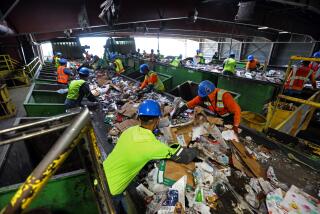Study Warns of Effects of Mixed Chemicals
- Share via
Expanding on evidence that environmental chemicals could be altering sex hormones, scientists have discovered that some pesticides with weak potential to imitate estrogen on their own become hundreds of times more potent when two are combined.
The findings suggest that exposure to mixes of chemicals routinely found in the environment could be posing a much greater risk than suspected, and that government screening of pesticides may be inadequately protecting the public from reproductive ailments and declining fertility.
As they report today in the journal Science, Tulane University scientists used a novel system to test four pesticides by genetically engineering yeast cells to add human proteins that send signals to produce estrogen. All four chemicals were weakly estrogenic alone. But when two--especially endosulfan and dieldrin--were paired, the potency rose by 160 to 1,600 times, a huge leap that stunned the researchers.
“The thing that was most compelling was the dramatic synergy between two unlike chemicals,” said endocrinologist John A. McLachlan, who led the Tulane team. “Instead of 1 plus 1 equaling 2, we found that 1 plus 1 equals a thousandfold. We expected interactions, but we were surprised they were so strong.”
Endosulfan is one of the most widely used insecticides in the United States, where about 2 million pounds are applied annually on fruit, vegetables and other crops. The other three compounds--toxaphene, dieldrin and chlordane--were banned by the Environmental Protection Agency in the 1980s but still contaminate many areas.
The pesticides were chosen because they commonly combine in many environmental settings, including Florida’s Lake Apopka, where alligators with feminized hormones and half-male, half-female genitals have been discovered.
National Institutes of Health hormone expert S. Stoney Simons Jr. called the results remarkable, but said in an editorial in Science that “as is often the case with significant new discoveries, this paper . . . poses more questions than it answers.” Key among the uncertainties is whether the effects on cells are comparable to real-life effects on humans or other animals.
Evidence that “gender-warping” chemicals boost estrogen or block testosterone and damage sex organs has emerged only in recent years. Yet the evidence has been mounting steadily, and it has become the topic of the hottest environmental health debate.
Tests in laboratories and on wild animals show that several dozen man-made chemicals can damage a fetus’ hormones and sexual development at fairly low levels. While adults may be unaffected by the exposure, the damage can be passed to the next generation through the womb.
Many animals, including Florida alligators, Great Lakes birds and Columbia River otters, have been born with excessively high estrogen levels, small penises or malformed testes that scientists have linked to pesticides and industrial chemicals.
In humans, though, the evidence is far less conclusive. Some researchers suspect that the fake hormones could be contributing to sharp drops in male sperm counts and rising rates of testicular and breast cancer.
Controversial studies of European men show that average sperm counts have dropped by nearly half in the past 50 years, but two U.S. studies of the past two decades have found no decline. Experts have not yet explained the differences.
The new research involved two of the most prominent scientists working on environmental hormones, McLachlan and University of Florida reproductive physiologist Louis Guillette Jr., who with his colleagues made the discovery of feminized alligators.
The results, if confirmed, could revolutionize how pesticides and other chemicals are tested for human health effects. If there are such strong cumulative effects, it might lead to new restrictions on products used by farmers, home gardeners and others.
“I was astounded by the findings,” said Dr. Lynn Goldman, the EPA’s assistant administrator overseeing pesticides and toxics. “I just can’t remember a time where I’ve seen data so persuasive as far as making an argument for synergy between chemicals. The results are very clean-looking.”
The EPA requires manufacturers to test chemicals individually, but not cumulatively, on lab animals. So the agency may be dramatically underestimating the risk when it determines what pesticides are safe to use.
The Clinton Administration, which has identified hormone disrupters as a top environmental priority, has recently begun efforts to refine the screening guidelines to detect changes in estrogen and sperm counts.
“We are going to need to immediately begin to look at the implications of this study and factor it in,” Goldman said. “This will have very important implications for our research and for managing the risks to public health and the environment. In nature, chemicals do not occur singly.”
Adding to the work on pesticides, the Tulane team found a five- to sevenfold increase in estrogen potency when two types of PCBs, or polychlorinated biphenyls, were combined, as they often are in electrical transformers and plastics.
The increase in potency means it took a much lower dose of the chemicals, when combined, to imitate estrogen. Still, the mixes were only one-fortieth to one one-thousandth as strong as natural estrogen, called estradiol.
Pesticide manufacturers say more research is needed to determine if there is any risk of human sperm problems or reproductive cancers at the relatively low levels of chemicals most people encounter.





